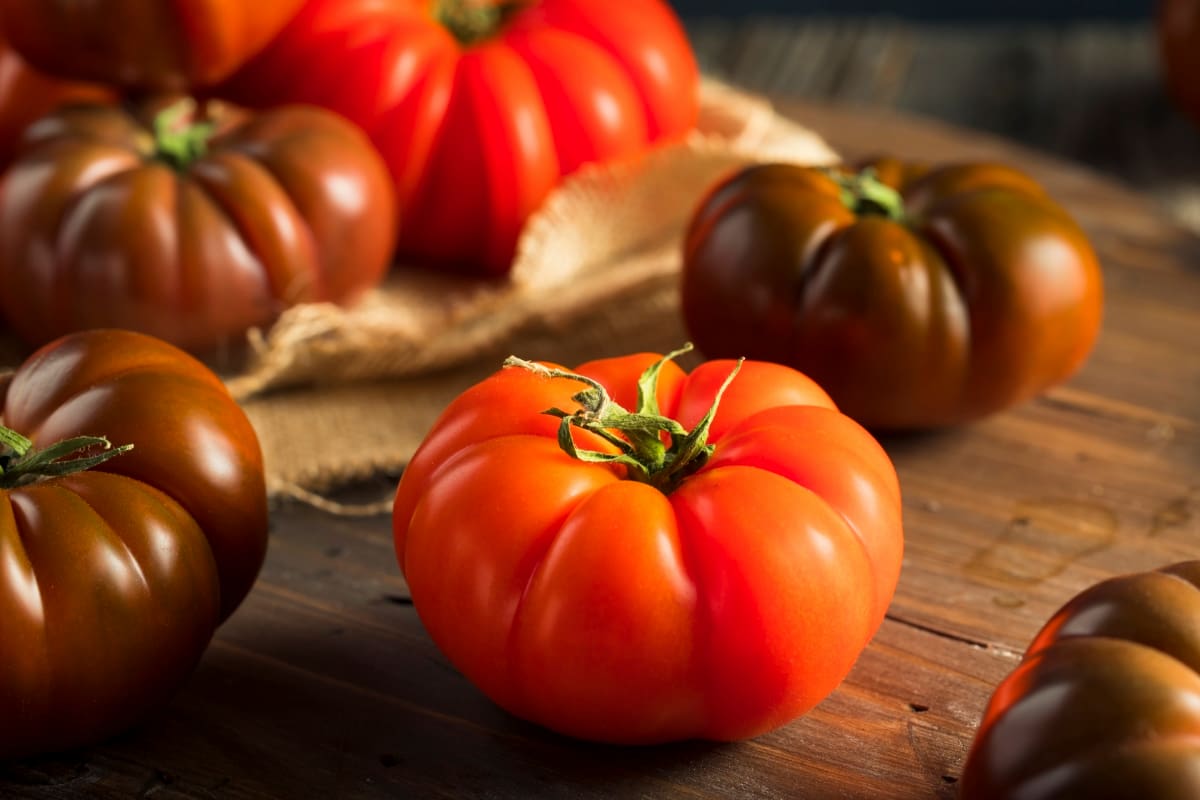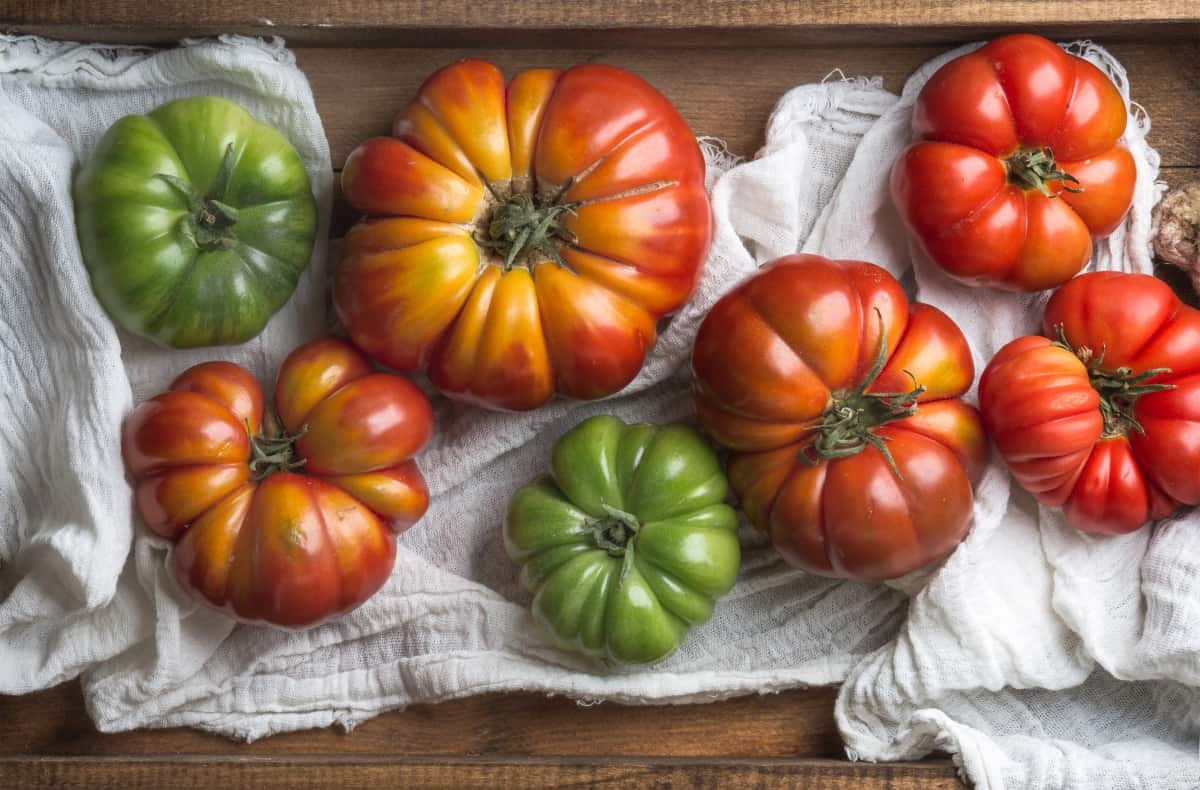Heirloom tomatoes are popular among gardeners due to their unique flavors and vibrant colors. Growing these tomatoes from seed to harvest can be a rewarding experience. This article will guide you through the step-by-step process of successfully growing and caring for heirloom tomatoes.

Best Soil Conditions for Growing Heirloom Tomatoes
One of the key factors for successfully growing heirloom tomatoes is having the right soil conditions. Heirloom tomatoes thrive in well-draining soil that is rich in organic matter. A pH between 6.2 and 7.0 is ideal for indoor and growing heirloom tomatoes in raised beds. Before planting, it’s essential to prepare the soil by adding vermicompost or well-rotted manure to improve its fertility and structure. This will provide the necessary nutrients for healthy plant growth and development.
Choosing the Right Heirloom Tomato Variety
There is a wide variety to choose from regarding heirloom tomatoes. There are many varieties of tomatoes, each with unique tastes, colors, and growth characteristics. It’s important to consider your preferences and growing conditions when selecting the right heirloom tomato variety. Some popular varieties include Brandywine, Cherokee Purple, and Mortgage Lifter. Researching and understanding the characteristics of different varieties will help you make an informed decision.
How to Grow Heirloom Tomatoes from Seeds
- To grow heirloom tomatoes indoors, Fill seeds trays or small pots with a lightweight seed-starting mix.
- The seed-starting mix can be applied lightly over the seeds but should not exceed 1/4 inch. Gardeners sometimes plant two to three seeds in each cell or pot due to the possibility of a few seeds not germinating.
- Make sure you water well. Put the pots in a warm, sunny place with a clear plastic dome or wrap covering them. Germination of tomatoes is best at a temperature between 24 and 29°C (you can use a seedling heat mat if your house stays cool).
- Observe the seeds for about a week to see if they germinate. Maintain the pots moist. Once the seedlings sprout, remove the plastic wrap or dome to allow good airflow and reduce disease risk.
- Once the seedlings have developed their first true leaves, thin pots containing multiple plants by pulling out the weakest ones.
- Continue to water your indoor plants until all danger of frost has passed. Once your plants’ roots outgrow their containers, transplant them into 4-inch pots once they have outgrown their small cells.
In case you missed it: How to Grow Black Krim Tomatoes: A Guide to Planting, Care, and Harvest

Transplanting Heirloom Tomato Seedlings
Upon developing their first true leaves and after the danger of frost has passed, heirloom tomato seedlings may be transplanted into the garden. For growing heirloom tomatoes in raised beds, Ensure the soil is well-drained and sunny before planting. Make sure the hole is deep enough to accommodate the root system of the seedling.
Ensure you do not damage the seedling’s roots when you remove it from its container and plant it in the hole. Soil should be filled around the plant’s base, gently firmed, and thoroughly watered. For growing heirloom tomatoes in a pot successfully if you give the root system adequate space. Decide whether you want determinate or bush tomatoes. Make sure the pot is at least a diameter of 18 inches. Approximately 24 inches is the minimum pot size needed for indeterminate tomatoes.
Providing Adequate Sunlight for Heirloom Tomatoes
Heirloom tomatoes require a minimum of 6-8 hours of direct sunlight daily to thrive. Select a spot that gets ample sunlight throughout the day. Ensure no obstructions, such as trees or buildings, could shade the plants. Consider using reflective materials or trellises to maximize sunlight exposure for your heirloom tomatoes if necessary.
Watering Requirements for Heirloom Tomatoes
Adding 2-3 inches of bark mulch, straw, or shredded leaves around your tomatoes will help keep them moist. How often to water heirloom tomatoes will depend on weather conditions and the variety growing. Make sure tomatoes are regularly watered, especially during sunny, hot weather. Whenever you feel dry soil on the top inch, stick your finger in the soil and water it. It is important to water your tomatoes regularly to prevent them from cracking, splitting, or developing blossom-end rot.
Fertilizing Heirloom Tomato Plants
When it comes to fertilizing these historical varieties, sometimes less is more. It is a good idea to start by testing the soil. Applying a complete NPK fertilizer with a rating of 10-10-10 when planting tomatoes is generally recommended. You can achieve the same results by top dressing with vermicompost in the spring or fall, with or without organic fertilizer, if you grow organic heirlooms. The more nitrogen the tomato plants receive once they set flowers, the bushier their vegetative growth will be, and the inferior quality of their fruit will result.
In case you missed it: How to Grow Better Boy Tomatoes: A Guide to Planting, Care, and Harvest

Pruning and Supporting Heirloom Tomato Plants
Pruning and supporting heirloom tomato plants are crucial for maintaining plant health and maximizing fruit production. For tomato plants to produce more fruit, remove suckers that develop in the leaf axils to encourage airflow and prevent overcrowding. Use stakes, cages, or trellises to support the plants and prevent them from sprawling on the ground. Regularly inspect the plants for any symptoms of pests and diseases and take corrective measures to control them.
Managing Pests and Diseases in Heirloom Tomatoes
- Aphids: These small, soft-bodied insects are one of the growing heirloom tomato problems and feed on the sap of tomato plants, causing yellowing and curling of leaves. Look for clusters of aphids on the undersides of leaves.
- Tomato hornworms: These large, green caterpillars can devour foliage and fruit. Look for chewed leaves and black droppings.
- Whiteflies: These tiny, white insects cluster on the undersides of leaves and suck plant juices, leading to stunted growth and yellowing of leaves.
- Pests control: Use botanical insecticides like neem oil or insecticidal soap as a last resort, following label instructions carefully.
Identifying Diseases
- Early blight: Dark, concentric rings on leaves and brown lesions on stems and fruit are signs of this fungal disease.
- Late blight: Dark, water-soaked lesions on leaves, stems, and fruit are characteristic symptoms of this devastating disease.
Managing Tomato Diseases
Use copper-based fungicides or biocontrol agents like Bacillus subtilis to control fungal diseases.
Harvesting and Storing Heirloom Tomatoes
Harvesting Heirloom Tomatoes
Wait until your heirloom tomatoes are fully ripe before harvesting. Heirloom tomatoes are known for their rich flavors, which develop at their peak ripeness. Gently twist the tomato from the stem when harvesting. Avoid pulling or yanking, as this can damage the fruit and affect its quality.
Storing
If you have an abundance of heirloom tomatoes you cannot consume before they spoil, consider freezing them. First, wash and dry the tomatoes thoroughly. Remove the stems, blanch them in boiling water for a few seconds. Then transfer them to an ice bath. Once cooled, remove the skins and freeze the tomatoes in airtight containers or freezer bags. Frozen tomatoes are best used for cooked dishes like soups, sauces, and stews.
In case you missed it: How to Grow and Care for Plum Tomatoes: A Step-By-Step Guide

Conclusion
Growing and caring for heirloom tomatoes is a fulfilling endeavor that allows you to experience these varieties’ unique flavors and beauty. You can successfully nurture your heirloom tomato plants from seed to harvest and savor the rewards of your hard work by following the steps discussed. Happy gardening!
- Feed Your Flock for Less: Top 10 Tips to Save on Chicken Feed
- Ultimate Guide to Ossabaw Island Hog: Breeding, Raising, Diet, and Care
- Hatching Answers: The Top 10 Reasons Your Chickens Aren’t Laying Eggs
- Eggs and Economics: Breaking Down the Cost of Raising Backyard Chickens
- Defend Your Greens: Proven Methods to Keep Iguanas Out of Your Garden
- Ultimate Guide to Cinnamon Queen Chicken: A Comprehensive Guide for Beginners
- Ultimate Guide to California Tan Chicken: Breeding, Raising, Diet, Egg-Production and Care
- Ultimate Guide to Marsh Daisy Chicken: Breeding, Raising, Diet, and Care
- 10 Types of Chicken Farming Businesses You Can Start for Profits